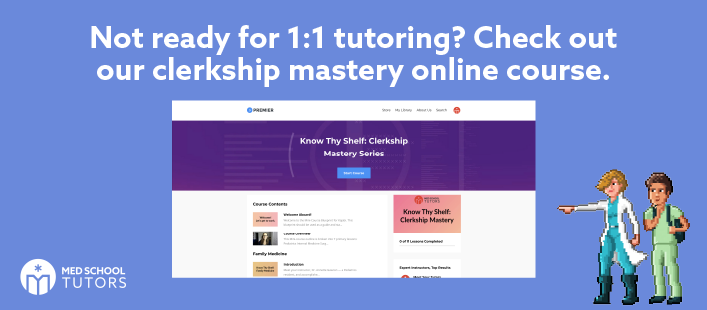[Nick Lunig, Dr. Brian Radvansky, and Erica Forrette contributed to this post.]
Imagine this: You started your third year with your surgery rotation. While you knew it was going to be time consuming, you were excited to interact with patients, work in the hospital, and never have to think about glycolysis again (which isn’t entirely true, but that’s a topic for another time). You knew you had a shelf exam at the end of the rotation, but at that point it was so far away and you were more concerned with succeeding on the wards. You think, “I’ll cross that bridge when I come to it.”
While you enjoyed your surgery rotation, the time commitment was as intensive as you had expected – and then some. It got to the point when you came home for the day, you were barely able to greet your roommates, cook yourself dinner and change out of your scrubs (which was probably the hardest part, because scrubs are basically doctor pajamas.) The thought of doing any studying was laughable. When the exam was one week away, you finally started to actually study… and quickly came to a tough realization of how woefully underprepared you were.
It was this precise scenario, survived by a contributing author and long-time USMLE tutor, that led to the creation of the “shelf exam study manifesto” you are now reading.
First, some basics:
What is a shelf exam?
The shelf exam is an officially licensed exam by the National Board of Medical Examiners (NBME) that pertains to a particular subject (such as internal medicine, surgery, OB/GYN, neurology, psychology, and pediatrics). Shelf exams are composed of retired USMLE questions that have been “shelved” and are no longer seen on USMLE Step 1 and Step 2 exams. That said, some questions you see on Step 1 & 2 will be INCREDIBLY similar to those you’ve seen on shelves. So pay attention!Shelf exams are usually given at the end of your rotation, and are available for basic science subjects like Physiology and Pharmacology, as well as clinical science subjects (i.e., rotation-based) like Medicine, Surgery, and Pediatrics.
How does studying for Shelf exams differ from Step 1?
One major difference between Step 1 and the Shelf exams is that Step 1 requires you to draw from your knowledge of basic science to connect the vignette to the correct answer. Or at least eliminate incorrect answers. This is true of the USMLE Step 2 CK as well. In contrast, Shelf exam questions rely on clinical reasoning to arrive at the correct diagnosis or treatment. The end result is that clinical experience becomes an invaluable asset on test day.
Does my NBME shelf exam score matter?
There is a good chance that your med school will use your shelf exam score in calculating your final grade. Depending on how your school computes your grade, the shelf exam can range anywhere from a big deal to a huge deal! Your grade might be composed of 80% “clinical performance” and 20% shelf score. Or it might be closer to 60% clinical, 40% shelf. A typical way that shelf exams are used is to assign some portion of the overall clinical rotation or lecture course grade (usually 20-30%) to the corresponding NBME subject exam. In other words, the Shelf exams are certainly important, but just how important is determined by your specific med school.On top of that, the scores you obtain become part of your USMLE record, and while they aren’t the highest on the list of what program directors care about at match time, you might have some explaining to do on your pediatrics interview if you failed your peds shelf. Grades obtained in the clerkship as a whole are relatively important.Some schools might also necessitate a certain score on the shelf in order to achieve a certain grade in the clerkship. That is, you might need an 80 or better for Honors, or you might need a passing grade to pass the clerkship.The beautiful thing about the shelf exam is that it provides you (and your institution) with a real perspective on how you match up at the national level. This can help you see what subjects you need improvement in, as well as telling your school what parts of their curriculum might need more attention. As a standardized set of shelf examinations from the National Board of Medical Examiners, the Shelf exams are arguably the most objective metric for assessing a student’s problem-solving and clinical skills. However, the way in which Shelf exams are used is left up to each medical school and therefore can differ from one institution to another.The NBME Shelf exams in and of themselves are not required for licensing—unlike the USMLE Step exams—but med schools frequently use the Shelf exams for assessing clinical proficiency from clinical rotations, or medical clerkships, and successful completion of these rotations are a licensing requirement. Similarly, the Shelf exams covering basic sciences may be incorporated into lecture or laboratory courses on related material.
How are shelf exams graded?
According to the NBME Clinical Science score interpretation guide, the clinical Shelf exam grading format will report your score as an equated percent score from 0% to 100%. The equated percent score indicates what fraction of subject matter questions you would answer correctly at your level of proficiency, and this is adjusted depending upon question difficulty.Currently, the mean score ± one standard deviation for US and Canadian medical schools is approximately 75 ± 9. Your score report, or performance profile, will provide not only your equated percent score, but also a graphical breakdown of your exam performance by subtopics covered on the exam.
What score do I need to pass my shelf exam?
A shelf exam “passing” score is decided by the medical school. It’s kind of like taking the SATs. There’s no passing score, but if your math teacher wanted to compute your SAT Math score into your final grade, they could decide if you “passed” it based on whatever arbitrary score they picked.What happens if you fail a shelf exam?Because medical schools often use the Shelf exams to measure their students’ proficiency from clinical rotations, failure of a Shelf exam can risk failure of the rotation for the corresponding clinical subject. For the basic science (non-clinical) NBME Shelf exams, a failing grade may result in failure of a lecture or laboratory course.It should be noted, though, that because of the variable way that Shelf exams are employed in different institutions, failing a NBME Shelf exam does not necessarily translate into not passing that rotation or course. Additionally, institutions have the option to allow medical students to retake Shelf exams.If your medical school allows retakes, if you fail a Shelf exam, it is advisable to retake it within 90 days of your first attempt. This is because initial Shelf scores can be completely expunged and replaced with the retake score if the retake occurs within 90 days after the original exam.
What material will be included on the shelf exams?
Schools don’t necessarily have students take every NBME shelf exam. The core clerkships of Medicine, Surgery, OB/GYN, Pediatrics, Psychology, and Neurology usually come with shelf exams. Whether schools use shelf exams for the basic sciences (Neuroscience, Physiology, Pharmacology, etc.) is quite variable, as schools sometimes use their own self-written tests instead.Obviously, this will vary based on the subject. You will certainly see the bread and butter diagnosis and management of common pathologies. Some conditions you can certainly expect to see:
- Medicine: Heart failure, COPD, liver disease, acute kidney injury, diabetes.
- Surgery: Very “medicine-based.” That is, very little surgical anatomy, much more diagnosis and post-op management. Cholecystitis, appendicitis, post-op fever, any intra-abdominal organ disease, trauma evaluation.
- OB/GYN: Pre-eclampsia, prenatal management, vaginitis, abnormal uterine bleeding, STIs, physiologic changes of pregnancy.
- Pediatrics: Dehydration, meningitis, limp, normal development, asthma.
- Psychiatry: Depression, personality disorders, substance abuse, schizophrenia.
- Neurology: Movement disorders, multiple sclerosis, nerve injuries, localizing the lesion!
There will also be less common pathologies that are germane to a particular specialty, but that you would be unlikely to encounter in a 4 week rotation. Your knowledge of Creutzfeldt-Jakob disease and meningomyeloceles will probably come from reading and not your day-to-day.
How do I prepare for the shelf exam?
The usual dogma applies here: let your clinical encounters be the foundation of your knowledge. But, over the course of the clerkship, you likely won’t encounter all the zebras that you are going to be tested on.Therefore, it is essential that you read frequently, and study outside of your clinical encounters.As a med student, you won’t be carrying a census of 13+ patients to learn from; it will likely only be 2 or 3, tops. It is only through supplemental materials (like case files, and the old-school textbook) that you will get to an acceptable level of knowledge for shelf success.We know this isn’t easy. After a 12+ hour shift of being in over your head, there often isn’t a lot of extra fortitude left for hitting the books. Be creative, find a way, and learn as much as you can. Doing UWorld questions also makes for a great supplement to your rotations.Determine high-yield topics AND make a schedule that covers all of them with at least a couple days before the shelf exam. We thought the OnlineMedEd video series was very good for providing an outline of the high-yield topics. Your study time is much more valuable for the Shelf exams, as it is harder to come by, which makes your schedule all that more important.We asked Barrett H. (at the time, an MD/MBA student at the University of North Carolina School of Medicine & Kenan-Flagler Business School) how he thought medical students could use practice tests as part of their shelf test prep. Barret replied, “Practice tests and questions are just that: practice! Resist the temptation to use them diagnostically. All of my NBME practice scores fell within two points of each other, but my raw and percentile shelf scores were much more widely distributed. UWorld and other question banks are created with an educational objective in mind for each question. They are incredibly useful learning materials. The NBME practice exams are made up of retired test questions from actual shelf exams, so they are your best glimpse into what your shelf exam will be like. Try to take at least one practice exam a week or two before the shelf exam. No matter what your score, remember that you still have one to two weeks of studying. If you can’t fit one in that far in advance, try not to take a practice exam in the last few days before the real deal. Bombing a practice exam right before test day can get you trapped in a very bad headspace!”
What’s test day like?
Taking the shelf exam is like most exams. It will probably occur on a weekday in your school’s computer lab. There are far fewer hoops to jump through than for your USMLE Step exams. Show up well-rested, calm and collected, and do what you were born to do: answer multiple choice questions over and over… And now on to shelf exam study tactics!
NBME shelf exams tips from us to you:
- Don’t drive yourself crazy with a strict daily study schedule.
There are some days you will joyfully skip out of the hospital at 4:45 PM and others you will be scarfing down cafeteria chicken nuggets at 7:00 PM because you are already late for your next case. If you go home on those late days with the feeling that you also need to read 4 chapters of Pestana’s that night, it will cause you undue stress and make you try to study when you aren’t retaining anything. We recommend creating weekly “tasks” so that those days when you do get home at 4:45 PM, you can do a little extra that night and when you end up leaving at 9:00 PM, you don’t feel obligated to stay up until 1:00 AM.Regarding his own study schedule, Barret said, “At the beginning of each rotation, I identified the resources I wanted to use and tried to divide the number of pages to read or the number of questions to work through by the number of days available for studying. I had a daily goal to work towards, which was really helpful because it gave me a sense of whether I was covering enough material daily. I always tried to leave a couple of days right before the shelf for dedicated studying, and I tried to work in an NBME practice test 1 to 2 weeks before the shelf. I made studying a daily habit, even if I knew I didn’t have time to hit my goal on a particular day. Any progress is better than no progress!”
- You will NOT be fully prepared for the shelf exams by only learning from the patients and cases you see during your days on the wards.
We do believe that seeing a disease first hand is the best way to learn it, but there is no way you are going to see everything you need to know for Urology AND Ophthalmology AND Surgical Oncology in 8 weeks or less. You need to sit down and read about these topics in order to succeed.
- Like Step 1, don’t overwhelm yourself with the number of exam resources you use for each rotation.
There are so many books, flashcard sets (such as Memorang’s IM shelf deck), and videos for every single shelf. No matter which rotation it is, it is better to pick a few quality resources and truly go through them than skim a whole bunch of them. Of his own experience with exam resources, Barret said, “I used UWorld and OnlineMedEd videos for every rotation. OME was useful as a primer or high-yield review. I treated UWorld as an interactive text and tried not to pay attention to percent correct or incorrect. I also took at least one NBME for most rotations to get a feel for how clinical concepts in each field might be tested. I did not find NBMEs to be useful predictors of Shelf scores.”
- Don’t marry yourself to one “series” of resources for each rotation (such as Blueprints, First Aid, etc.).
“Case-Files for OB/GYN” was by far my most valuable resource for that rotation. “Case Files for Internal Medicine” was insufficient for the shelf exam. Ask your peers or residents if they have any resources that really helped them prepare for the shelf exam you have coming up. You’ll find as you go along that you will prefer a different resource for each rotation.Check out Barret’s resource recommendations for each rotation:Family/Outpatient Medicine: Case Files and PreTestNeurology: Case Files and PreTest. In this particular rotation, these two resources really shined.Psychiatry: I used First Aid for the Psychiatry Clerkship exclusively and found it sufficient for the boards and the wards. Whatever you end up using for this rotation, make sure it’s been updated to reflect changes in the DSM-5.Pediatrics: Case Files and PreTest. This shelf is broad and difficult, but I found that reading up on patients was especially helpful for this shelf.Ob/Gyn: Case Files, PreTest, and First Aid for the Obstetrics and Gynecology Clerkship. I found the First Aid for this clerkship to be useful as a quick reference while working through the other two texts.Internal Medicine: Step-Up to Medicine and UWorld. Because this is the broadest shelf exam, I chose a more comprehensive text. Medicine is the largest category on UWorld, so there are plenty of practice questions to work through.Surgery: DiVirgilio’s Surgery: A Case Based Clinical Review was the only text I studied for the shelf. What makes this one of the best shelf-prep texts for any rotation is a case-based structure that not only explains the reasoning for the most likely diagnosis and treatment but also why other diagnoses and treatments are less likely or appropriate. It will feel like reading a medicine text, but remember – the Surgery Shelf is about knowing which treatment options to exhaust before choosing surgery, as well as pre- and post-op care. For learning about specific operations and the questions you might be asked in the OR, read Surgical Recall.
- It is okay to make changes to your study plan.
If a resource is simply not working for you, you don’t have to keep using it, even if your bestie loved it. While this holds true for Step 1 as well, it becomes a little more urgent for shelf exams because there is less study time to waste on an ineffective resource.“Despite the best planning and strongest commitment to a study schedule, there were many days where it was just not possible to meet my daily goals,” Barret said. “There were a few where I couldn’t study at all between clinical duties, other obligations, and sleeping. When I missed a day, I tried to make up the missed work over the next day or two. Bigger schedule disruptions required a more thoughtful evaluation of my progress and goals before reworking my study plan. In some cases I could increase my daily goals for the rest of the rotation, but there were a couple of times where I had to completely rework my study plan for the time I had left before the shelf. These were times where I had to think about which resources were highest yield for me personally and then focus on those for the rest of the rotation. For example, I might focus on more detail-oriented resources in a rotation where I felt comfortable with the fundamentals, or I might choose to abandon a nitty-gritty, nuanced resource in order to make sure I had a grasp on the core concepts in a rotation where I was having trouble learning the material. Flexibility is key.”
- Take the shelf exam seriously.
The shelf exam can be a huge deal, but it doesn’t have to be full of drama and fear. How to turn it from foe to ally? Be prepared. The most important thing you can do to be ready for the shelf is to START READING FROM DAY 1 OF YOUR CLERKSHIP. Build the habit from the get go. Even if it’s just a single condition or a few case files. It is so hard to play catch up when encumbered by your rotation. Read, read, read …early and often, and the shelf exam will be a satisfying way to demonstrate your dedication and mastery of a subject.
- You mentioned high-yield shelf exam study. How do I know where to start?
We’re glad you asked! Dr. Brian Radvansky has an ongoing series of high-yield shelf exam study guides, many of which are linked here:Know Thy Shelf: Internal MedicineKnow Thy Shelf: Surgery Edition (and Surgery Edition Part 2)Know Thy Shelf: High-Yield OB/GYN Tips and a 6-week study planKnow Thy Shelf: PSYCH!Know Thy Shelf: PediatricsKnow Thy Shelf: NeurologySome parting words on shelf prep and Third Year: “To stay motivated,” Barret said, “remember a few things: you’re human, plans change, and experience teaches. As a human being, you need to sleep and fight stress. Sometimes there’s more benefit to an extra hour of sleep or a little time enjoying a hobby or the company of loved ones than banging out a few more practice questions. Realize that when you first create your study plan, there is no way for you to know exactly how feasible it will be to get through it all while balancing everything else in your life. There is no shame in reworking your study plan as you go! Finally, don’t underestimate the value of clinical duties as a learning experience. I was amazed at how many times I used my clinical experience to answer questions on shelf exams and Step 2. Read up on your patients, pay close attention on rounds, and ask questions about diagnostic and treatment processes.Third year is tough, but it’s a once in a lifetime learning experience. Good luck out there!”So study hard for the shelves but keep in mind that if you survived Step 1 you can survive anything. And lastly, enjoy third year if for no other reason than you sometimes get away with wearing doctor pajamas to work!





